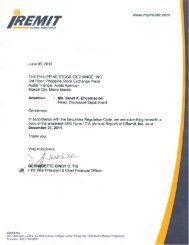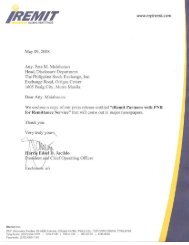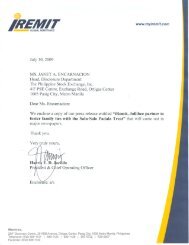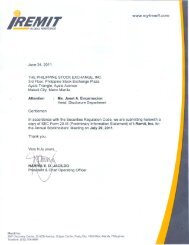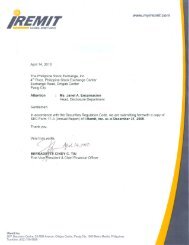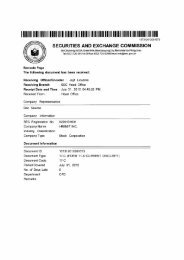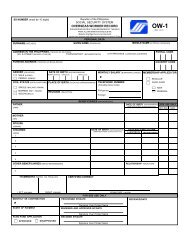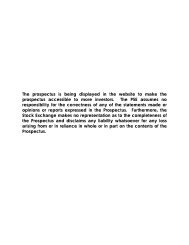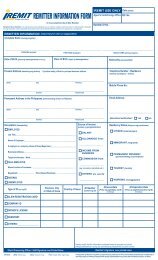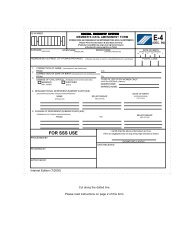SEC Form 20-IS - iRemit Global Remittance
SEC Form 20-IS - iRemit Global Remittance
SEC Form 20-IS - iRemit Global Remittance
Create successful ePaper yourself
Turn your PDF publications into a flip-book with our unique Google optimized e-Paper software.
- 5 -<br />
After initial measurement, other financial liabilities are subsequently measured at amortized cost<br />
using the EIR method.<br />
Other financial liabilities are classified as current liabilities when the Parent Company expects to<br />
settle the liability within twelve months from the balance sheet date. Otherwise, these are<br />
classified as non-current liabilities.<br />
Other financial liabilities include ‘Beneficiaries and other payables’ and ‘Interest-bearing loans’.<br />
Determination of fair value<br />
The fair value for financial instruments traded in active markets at the balance sheet date is based<br />
on their quoted market prices or dealer price quotations (bid price for long positions and ask price<br />
for short positions), without any deduction for transaction costs. When current bid and ask prices<br />
are not available, the price of the most recent transaction provides evidence of the current fair<br />
value as long as there has not been a significant change in economic circumstances since the time<br />
of the transaction.<br />
For all other financial instruments not listed in an active market, the fair value is determined by<br />
using appropriate valuation methodologies. Valuation methodologies include net present value<br />
techniques, comparison to similar instruments for which market observable prices exist, option<br />
pricing models, and other relevant valuation models.<br />
Day 1 difference<br />
Where the transaction price in a non-active market is different from the fair value from other<br />
observable current market transactions in the same instrument or based on a valuation technique<br />
whose variables include only data from an observable market, the Parent Company recognizes the<br />
difference between the transaction price and fair value (a Day 1 difference) in the parent company<br />
statement of income unless it qualifies for recognition as some other type of asset. In cases where<br />
use is made of data which is not observable, the difference between the transaction price and<br />
model value is only recognized in the parent company statement of income when the inputs<br />
become observable or when the instrument is derecognized. For each transaction, the Parent<br />
Company determines the appropriate method of recognizing the Day 1 difference amount.<br />
Derecognition of Financial Assets and Liabilities<br />
Financial asset<br />
A financial asset (or, where applicable a part of a financial asset or part of a group of similar<br />
financial assets) is derecognized when:<br />
• the rights to receive cash flows from the asset have expired;<br />
• the Parent Company retains the right to receive cash flows from the asset, but has assumed an<br />
obligation to pay them in full without material delay to a third part under a ‘pass through’<br />
arrangement; or<br />
• the Parent Company has transferred its rights to receive cash flows from the asset and either<br />
(a) has transferred substantially all the risks and rewards of the asset, or (b) has neither<br />
transferred nor retained substantially all the risks and rewards of the asset, but has transferred<br />
control of the asset.<br />
When the Parent Company has transferred its rights to receive cash flows from an asset or has<br />
entered into a pass-through arrangement, and has neither transferred nor retained substantially all<br />
the risks and rewards of the asset nor transferred control of the asset, the asset is recognized to the<br />
extent of the Parent Company’s continuing involvement in the asset. Continuing involvement that<br />
*SGVMC116501*



